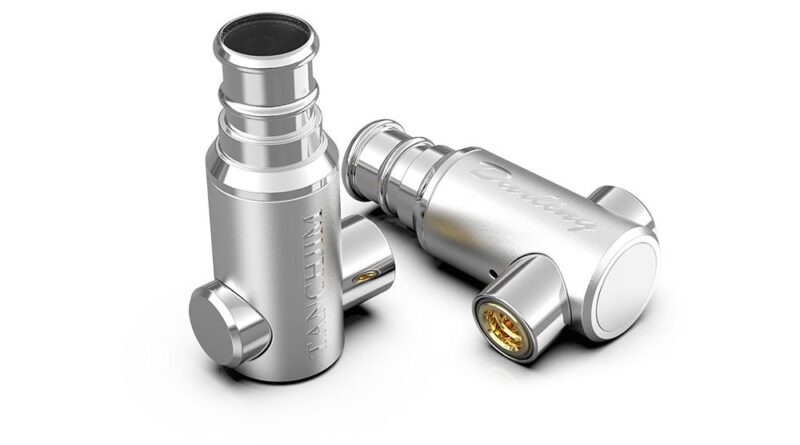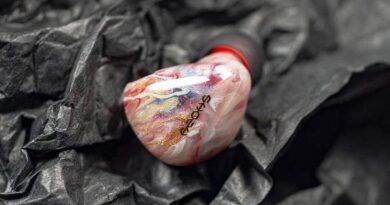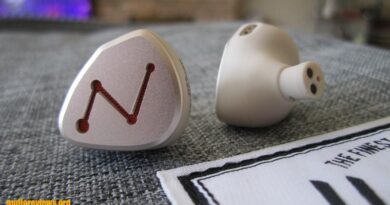Tanchjim Darling – A Rightful Upgrade
Today we talk about Tanchjim Darling, Tanchjim’s recently released flagship model which I auditioned with a lot of curiousity considering my appreciation for their direct predecessors Oxygen. Tested at $420.
In this Article
At-a-glance Card
| PROs | CONs |
| Natural acoustic timbre. | Not an all rounder – recommended for acoustic genres. |
| Neutral-bright tonality. | Competent source required. |
| Great imaging and separation. | Not inexpensive. |
| Perfect fast bass and sub-bass. | |
| Successfully calibrated highmids and brilliance segments deliver engaging clarity, detail, sparkles and air while always avoiding fatigue. | |
| Good female vocals. | |
| Good tuning coherence. | |
| Easy fit and comfort. | |
| Superb stock silicon eartips + interesting dual eartip fit depth opportunity offer effective further sound fine tuning options. | |
| Good stock cable. | |
| Good overall package. |
Full Device Card
Test setup
Sources: Apogee Groove + Liquid Spark / Questyle QP1R / Sony NW-A55 mrWalkman – Stock T-APB wide bore tips – Stock cable – lossless 16-24/44.1-192 FLAC tracks.
Signature analysis
| Tonality | Tanchjim Darling have a natural acoustic timbre. Tonality is bright-neutral, with successful care applied to avoid scanting into cold coloration. |
| Sub-Bass | Sub-bass is full extended all the way down, and generates a very nice rumble whenever called for. |
| Mid Bass | Tanchjim Darling midbass is punchy and fast, although not razor sharp which grants them a very good compromise between articulation and musicality. So-called bassheads won’t love this model, while it will be preferred by those who like acoustic and other undistored-bass genres, which bass will be rendered with the rightly calibrated level of texture and elevation, cornerstoned onto a note weight staying on the lean side. |
| Mids | The mid range is well executed in general, with particular regards to the high mids which are close to alltime great. Looking at the FR graph printed on the box one might be scared by the 3K hump in the curve but the real life rendering of that – when paired to an at least decent amp of course – is indeed a masterfully centered compromised: high notes are offered a very solid presence by this region, coupled with a superior level of details, and brilliance, without scanting onto sibilance nor fatigue. Very well done. |
| Male Vocals | On the lean side, although I can’t call them unbodied. There’s a decent level of articulation but not much more than that. I wouldnt recommend Tanchjim Darling for male-centric acoustic vocal tracks. |
| Female Vocals | Unlike male vocals females are bodied, shaped and superiorly articulated. May tend to go shouty only when paired to low-end sources – when that happens you know what you need to do. |
| Highs | The tuning choice is clear: enhance the brilliance section and let that work together with the 3K elevation in the high mids to add further air and sparkle, which is indeed the case. The presence section is kept more in the back to avoid exaggeration, which is a correct choice at this point. I reckon this is the origin of the eventual (but noticeable) lack of resolution on some cymbal-crowded passages. |
Technicalities
| Soundstage | Quite extended on the 3 axes (if, of course, the upstream DAC knows its job), although the depth dimension is less prominent than the others. |
| Imaging | Extremely good. Instruments are properly cast on the stage, in a natural and coherent way. |
| Details | Bass, high mids and low trebles are all delivering a very significant amount of detail, each for its own competence of course. The low range DD is doing a very good job with bass and contrabbassos down there, and the tuning choices applied onto the Sonion BAs are delivering superior retrieval up above, while always staying south of fatigueness. |
| Instrument separation | Layering is also well done on Tancjhim Darling. All intruments and voices are properly layered, and even on jazz “big bands” each instrument can be easily followed separately. As previously noted about Treble, some occasional lack of resolution may be noticed on overcrowded cymbals passages. |
| Driveability | Driving Tanchjim Darling appropriately may be a problem, due to their 9.5 Ohm impedance and their extremely low sensitivity. Don’t be mislead by the numbers printed on the box: 110dB/Vrms correspond to just 90dB/mW, which is VERY low. Such low value is on one (good) hand responsible for Tanchjim Darling’s very good performance on high mids and low trebles, but will require an amp (or dap) with above average capability in terms of current delivery which is not so common to find in the sub-500$ market so be warned and (I recommend) check you have the right source before you buy. |
Physicals
| Build | Full metal housings promise high resistance over time. The front nozzle comes with a dual ringed design allowing the user to insert eartips at 2 different depth levels. Fitting the eartips deeper onto the nozzle changes their sonic impact. And, depending on eartips fitting depth a deeper in-canal insertion level can be facilitated which is another independent way to reach a different sound flavour – the deeper the insertion the more evident trebles will be, while highmids will be a tad tamed down. |
| Fit | Tanchjim Darling are extremely easy to fit once the appropriate eartip size is identified. |
| Comfort | I personally find bullet-shaped IEMs very comfortable but I’m aware that milage vary very much on this topic. Even when deeper inserted into (my) canals, housings do protrude a bit from the ear so I would not recommend Tanchjim Darling to anyone willing to fall asleep with them anyhow. |
| Isolation | Bullet-shape housings offer limited passive sound isolation, which can be improved a bit by deepening the insertion point into the canal. |
| Cable | Not much info is discolsed by Tanchjim about the cable which is said to have a “special material” core surrounded by “several” silver foils. For what it’s worth, I find it sonically very good. On the other hand I’m not fond of the realtive stiffness of its plastic sheat. No earhooks are preinstalled which allows for both ear-down or round-ear dressing depending on user preference (I’m on the latter side). MMCX connectors are “just” a little bit picky: after getting initially alarmed by some connectivity drops during my very first listening sessions I understood it’s important to make sure to press the cable’s male MMCX terminals into the housings “all the way down” (with a stronger “intention” than I’m used to with other models, to so say). Lastly, and uncommonly, the sole indication telling the user which MMCX channel is which is an (uncolored) protruded dot existing on the Left terminal only. |
Specifications (declared)
| Housing | Bullet-shape full metal housing developed on Finite Element Analysis methods. Front nozzle allows for dual eartips fitting depth options. |
| Driver(s) | 1x 6mm dynamic driver + 2x Sonion Balanced Armature drivers |
| Connector | MMCX |
| Cable | Low capacitance & inductance silver foil wire, 3.5mm termination |
| Sensitivity | 110dB/Vrms (approx 90dB/mW) @1kHz |
| Impedance | 9.5 Ω |
| Frequency Range | 8-50000Hz |
| Accessories and package | Carry case, 1 set of S/M/L T-APB wide bore silicon tips, 1 set of S/M/L T-APB narrow bore silicon tips, Tanchjim badge, spare cloth meshes |
| MSRP at this post time | $419,99 |
Nozzles and eartips
Tanchjim Darling come with two very interesting features, which are well worth a separate note. For one, the housings’s nozzles are shaped in such as way as to allow for 2 different eartip fitting levels. Secondly, inside the packed Tanchjim ships their new T-APB silicon eartips.
Let’s start with the nozzles:

Those two relieved rings on the nozzles facilite fitting eartips “more on the tip”, or “deeper down”, upon free user choice, with two notable consequences: fitting the tip deeper onto the nozzle shortens the total nozzle length (which of course includes the eartip’s cylindrical body once fitted), and oppositely, fitting the tip less makes it easier to obtain a deeper overall insertion into the ear canal, or better said, makes it easier to fit the housings + their tips into the ear canal pushing them closer to the timpanus.
Both such actions do impact on the sound. In particular, deeper canal insertion will somewhat tame highmids and enhance Presence.
The other notable element is T-ABP eartips.

These are newly developed silicon eartips by Tanchjim, which come in two flavours labelled “B” and “T”, short for “Bass enhancing” and “Treble enhancing”. “B” tips feature a smaller opening, “T” tips a wider one.

Their silicon umbrella fabric is superbly well calibrated, not too soft not too hard, extremely comfortable also for long sessions. Silicon umbrella comfort is particularly welcome in bullet shaped housings like Tanchjim Darling whereby the user may want to opt for a deeper fit.
I must say I’m really impressed by them: they are in facts fantastically comfortable, and they do precisely deliver on their marketing claims in terms of sound shaping: narrow bore tips (“B”) do enhance mid bass and midrange, while wide bore (“T”) tips enhance high mids, vocals, trebles and – thanks to the extra treble air – soundstage.
Apart for the 2 set (1 S/M/L B-type, and 1 S/M/L T-type) they can of course be purchased separately from Tanchjim, for the not cheap price of € 14,99 for just 2 pairs! (1 per type, same size-letter). Which, considering the size-letter inconsistency (see picture above), if like me you want 1 pair of 12 mm Bass tips and 1 pair of 12 mm Treble tips you are forced to buy 2 packages (and waste 1 pair from each). Ah, well…
Notable comparisons
Unique Melody 3DT
3 Dynamic Drivers, 25.4Ω impedance, 113dB sensitivity, $299 street price.
UM 3DT offer a 10-15% heavier bass note weight (although still in punchy unbleeding territory). On the other hand mids and highmids are less athmospheric, dryer actually – which makes UM 3DT come out more bodied from approximately 500Hz down, but not really warmer overall, possibly the opposite actually. As a main jazz listener, I find Tanchjim Darling’s timbre more “natural” than 3DT’s.
3DT are a bit less fantastic than Tanchjim Darling on the highmids, where I get them less detailed and more prone to glaring. On the other hand I could not spot any defaillance on crowded treble passages, where 3DT’s highend-dedicated DD behaves much better than many BAs I heard in whole truth.
Vocals are rendered quite similarly by the two: females better than males. Soundstange, imaging and separation I would say also on par.
Fiio FH7
1 Beryllium-plated DD + 4 Knowles BA, 16Ω impedance, 111dB sensitivity, $499
Bass is equally extended but definitely slower on Fiio FH7. At times I find midbass too bloomy, rarely even bleeding. This imposes a much warmer color to FH7’s tonality compared to Tanchjim Darling.
Mids are evidently more bodied on FH7, especially the central part. Male vocals – while still not at “specialistic” level – are better structured and articulated compared to Tanchjim Darling. On the opposite end, females are unbodied and often very close to sibilance
Highmids and treble are tuned just oppositely on FH7 compared to Tanchjim Darling: FH7’s highmids are kept “calmer” , and Presence is enhanced. This is probably the origin of some too thin overtones coming out quite often which contribute to give an occasional but noticeable metallic aftertaste to FH7 highs, which is totally absent on Tanchjim Darling.
Even with a lesser prominence imposed to their highmids, FH7 and Darling do compete well in terms of detail retrieval with Tanchjim Darling leading by a modest edge. FH7’s stage lacks depth big time, while (possibly as a consequence?) instruments appear even better scattered, but on the X axis only.
Tanchjim Oxygen
1 Carbon Nanotube Diaphragm DD, 32Ω impedance, 110dB sensitivity, $249
Under some points of view Tanchjim Darling can be considered Oxygen’s direct upgrade. Simply put: the low end and lowmids are very similar, with most differences coming up from the high midrange up – which is totally logical considering Oxygen exploit a single DD for the entire spectrum, and Darling pair a DD with 2 Sonion BAs dedicated to the higher frequencies.
Oxygen’s midbass are just a tad more “flowery” than Tanchjim Darling’s and this, paired with a more “polished” (read: less sparkly) highmids and treble rendering gives them a definite smoother timbre, and more neutral-balanced tonality compared to Tanchjim Darling’s bright-neutral one.
Tanchjim Darling delivers 20%+ more sparkles, brilliance and sheer details from 2KHz up and that’s totally apparent – all without losing Oxygen’s competence on avoding sibilance or fatigue, which is a notable result, if well paid by the asking price of course.
The extra treble air grants Tanchjim Darling a somewhat airier stage too: on close listening the sheer stage size is actually similar but instruments feel better separated on Darling – there’s more “clean air” between each other, in facts.
Oxygen is much easier to drive, and costs 40% less, there’s that too of course.
Conclusions
Simply put, Tanchjim Darling’s are Oxygen’s direct upgrade and rightfully take their seat as Tanchjim’s new flagship model. If you are shopping for mid-tier IEMs to enjoy acoustic music such as cool jazz, bebop & similar they are a solid recommendation. Just make sure you check your source is not a low-end one or some of Tanchjim Darling’s capabilities will not shine as they otherwise could.
The sample has been provided courtesy of SHENZHENAUDIO, and you can buy Tanchjim Darling on their website, here.
Our generic standard disclaimer.
This article is also going to appear on my personal blog, here.
You find an INDEX of our most relevant technical articles HERE.











